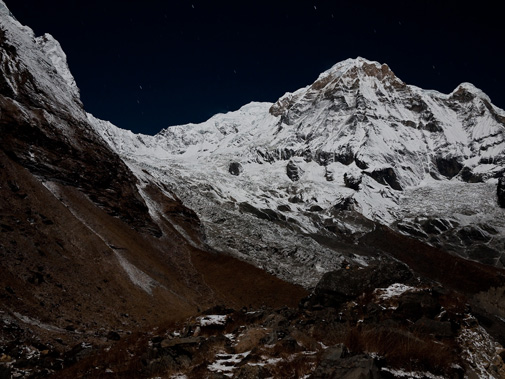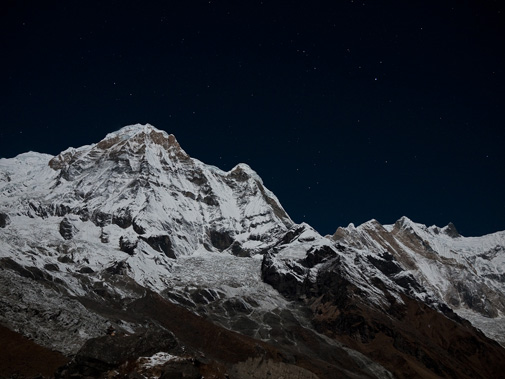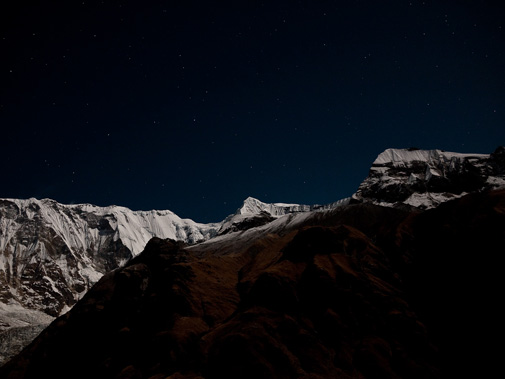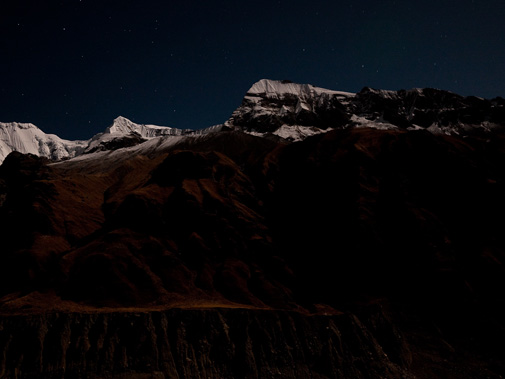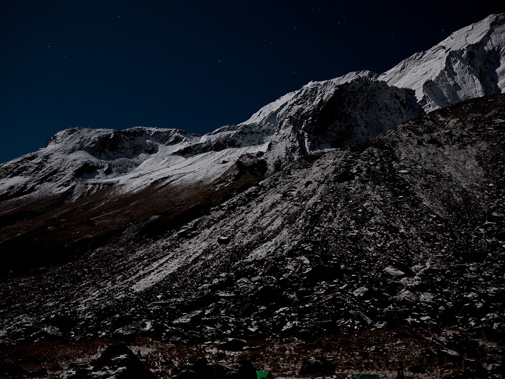Annapurna Moonrise
What is above knows what is below, but what is below does not know what is above. One climbs, one sees. One descends, one sees no longer, but one has seen.
— René Daumal
I arrived at Annapurna Sanctuary, 4200 meters into the Himalayas of Nepal on November 2nd, 2009. By pure chance it was my 29th birthday. It was also a full moon.
With a thermos of hot water wedged into my jacket, I made my way back beyond base camp, onto a ridge overlooking the vast moraine at the foot of Annapurna South.
There, I setup my tripod.
Surrounded by Buddhist prayer flags and rock piles, I slowly took these photographs of the utterly desolate terrain.
It was freezing but breathtaking.
And the best damn birthday present you can imagine.
These were all taken with a Panasonic Lumix GF1, about which I’ve written extensively.
— Craig Mod, February 2010Moonrise #1

60 sec @ f/7.1, ISO 100
Why climb?
It’s day six and my body has finally acclimated. Not to the altitude but to the activity: the rigor of climbing every day. Of carrying up and up a heavy load.
Each day requires six to eight hours of hiking. At dusk, I eat two days worth of food. I read and write until I can't keep my eyes open, and then sleep ten solid, unbroken hours. This routine, of course, feels right.
For many, base camp is a launching point — a shelter to gather yourself before the real climb. For me, on this trip, base camp is the destination. And while the peaks now look so close — they’re right there! — you can imagine how hard that final push must be.
It’s easy to dismiss climbing. Which is why I think it’s so dangerous to do so.
“You climb up, you come down. What’s the point?” Inevitably, I’m asked this.
Moonrise #3
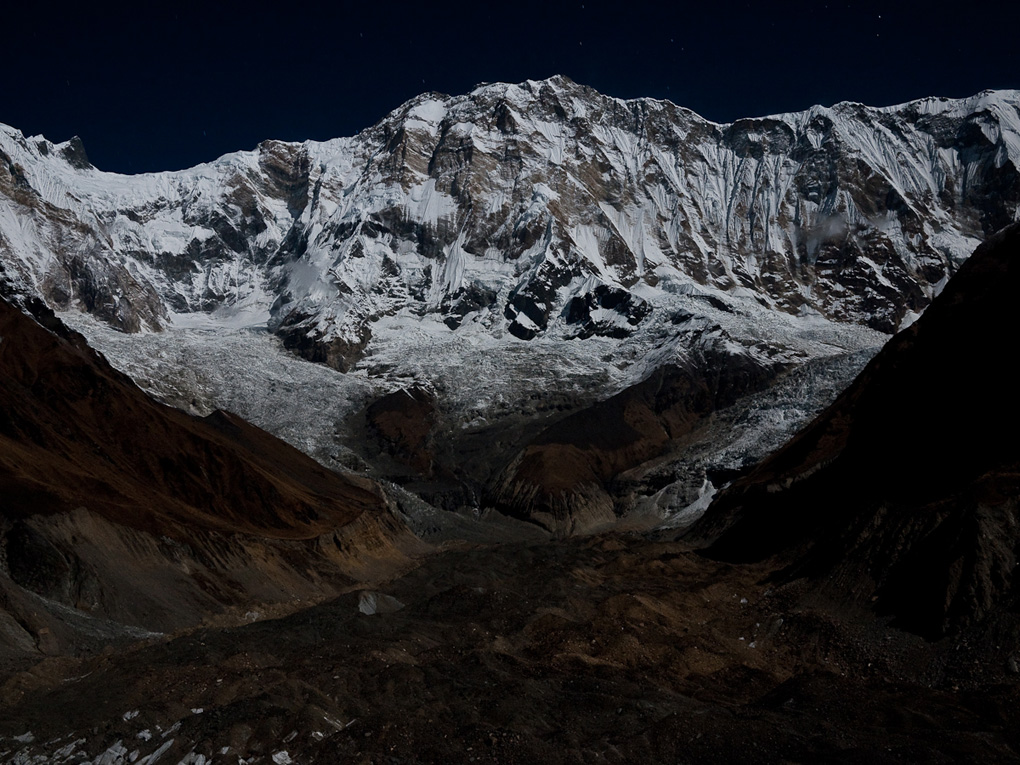
60 sec @ f/7.1, ISO 100
Climbing is meditation. I've long since realized this is why I'm drawn to this kind of activity.
By 'meditation' I mean, having space to think. Feeling an emptiness in the mind that enables you to consider solutions to tough problems, or not-so-tough problems, or just, god forbid, to relax. I find I need doses of this space in regular intervals.
I'm not the only one who feels a connection between movement and thinking:
"I can only meditate when I'm walking. When I stop, my mind ceases to think; my mind only works with my legs."Jean-Jacques Rousseau
There is even a phrase in Latin — solvitur ambulando — meaning, "it is solved by walking".
Obviously, climbing to Annapurna base camp is an extreme (Obsessive? Neurotic?) example of 'walking.' But I think when walking is referenced, what we're really speaking about is rhythm or cadence.
There is a rhythm to hiking, as there is in walking. And once you find the cadence — after a day or two — your mind empties. All your social obligations related to work and friends and life are made mute. They aren’t gone: they just no longer require your direct attention. There is a beauty in the simplicity of this silence. It’s as if every day of our lives is filled with a white noise. And suddenly, in the presence of these unbelievable peaks, the noise is gone.
Moonrise #5
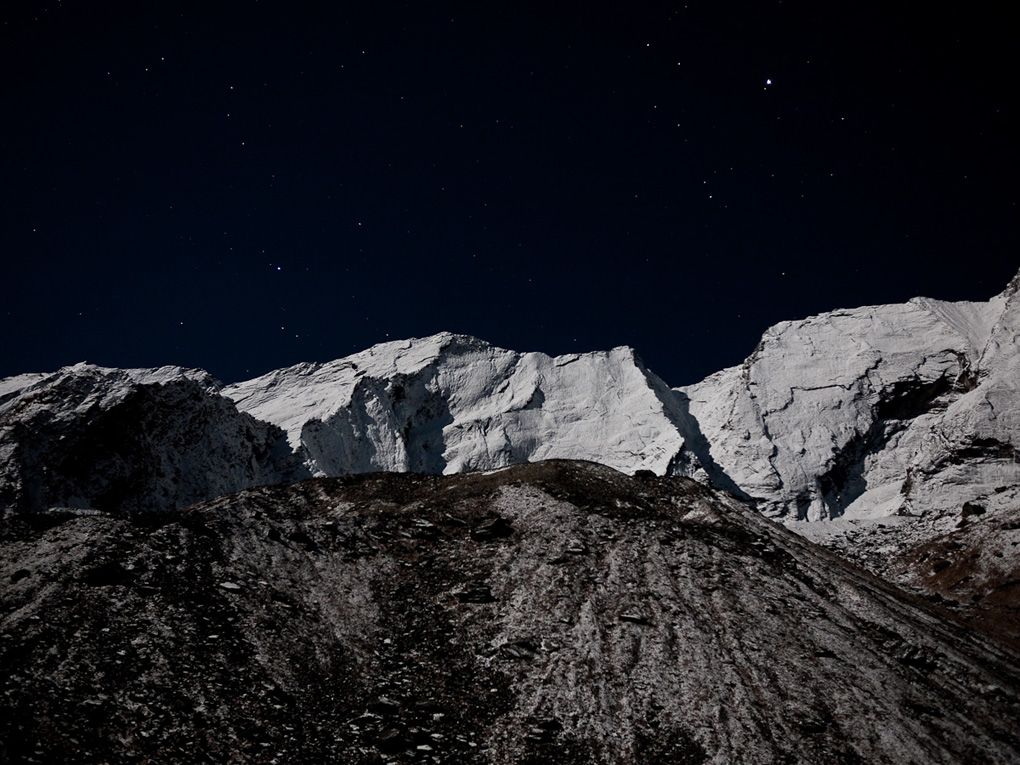
2.2 sec @ f/8, ISO 100
Of course there is also the physical 'pleasure' of climbing.
On the side of a mountain you are acutely aware of your body. Of having aching arms and legs and lungs that are too weak. Shoulders that feel like they might start bleeding at any moment. An uncanny ability to sweat all day, rendering yourself a wet mop of a man. And cells begging for more oxygen than you’re supplying them.
You feel food turn into fuel. A piece of chocolate after hours of continuous ascent instantly manifests as pure energy. Have you ever experienced this? It's biological magic and makes you realize just how direct that connection is between food and our body.
You sleep more deeply and peacefully than ever. Taste becomes explosive — everything delicious or revolting.
In sustaining this activity — extended, continuous exertion — there's a surreal wonder in watching your body change. Your very physicality sharpens. Fat burns off (despite eating and eating and eating). You whittle yourself down to the elemental components of pure muscle and bone. And on a mountain, standing there naked in the freezing cold in the morning, catching a glimpse of yourself in a dirty mirror, you think that you look both utterly homeless and pehaps hopeless, but also like a superhero.
Moonrise #7
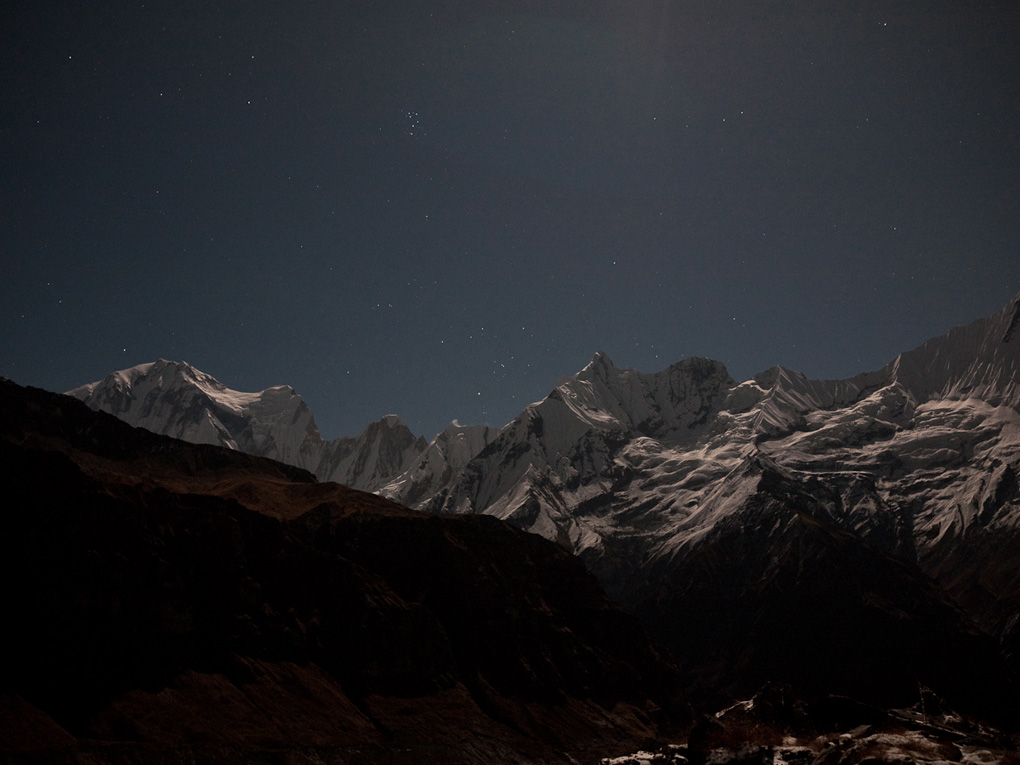
10 sec @ f/2.8, ISO 100
"You climb up, you climb down. What's the point?"
There is the obvious response: to stand before nature writ raw, to taste new tastes at new heights, to brush against the humanity of the mountain villagers, to forge new friendships, to, you know, challenge yourself — in a sense, to embrace adventure.
But, less obviously there are the meditative and physical aspects: the pure, piercing awareness and joy of being alive in every step you take towards your goal. Dramatic? Yes. But those are 8,000 meter peaks we're basking in. It's hard not to be dramatic.
The Daumal quote continues: There is an art of conducting oneself in the lower regions by the memory of what one saw higher up. When one can no longer see, one can at least still know.
If you can bring even a sliver of that feeling down and apply it to your every day life — "to conduct oneself in the lower regions by the memory of what one saw higher up" — then that alone is reason enough to climb up and then climb down.
Equipment Used For the Above Photos
About the images
All images © Craig Mod 2010.
Image reproduction is available under the Creative Commons Attribution-Noncommercial-Share Alike license. If you wish to use these photos in a commercial context, please contact me directly.
Creative Commons

This work is licensed under a Creative Commons Attribution-Noncommercial-Share Alike 3.0 United States License.
Equipment
All images taken with the Panasonic GF1 + Lumix 20mm f1.7 pancake lens. All post-processing done in Adobe Photoshop Lightroom 2.

